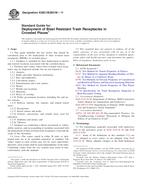Potrebujeme váš súhlas na využitie jednotlivých dát, aby sa vám okrem iného mohli ukazovať informácie týkajúce sa vašich záujmov. Súhlas udelíte kliknutím na tlačidlo „OK“.
ASTM E2831/E2831M-11
Standard Guide for Deployment of Blast Resistant Trash Receptacles in Crowded Places
Automaticky preložený názov:
Štandardné Príručka pre nasadenie vysokých Resistant Trash Kapacity v preplnených miestach
NORMA vydaná dňa 1.7.2011
Informácie o norme:
Označenie normy: ASTM E2831/E2831M-11
Poznámka: NEPLATNÁ
Dátum vydania normy: 1.7.2011
Kód tovaru: NS-46104
Počet strán: 5
Približná hmotnosť: 15 g (0.03 libier)
Krajina: Americká technická norma
Kategória: Technické normy ASTM
Kategórie - podobné normy:
Instalace a zařízení pro odstraňování a zpracování odpadů
Ochrana proti výbuchu
Anotácia textu normy ASTM E2831/E2831M-11 :
Keywords:
blast resistance, building survey, deployment, explosive, facility, fragments, security, trash receptacle, venue, ICS Number Code 13.030.40 (Installations and equipment for waste disposal and treatment), 13.230 (Explosion protection)
Doplňujúce informácie
| Significance and Use | ||||||||||||||
|
This standard is intended to provide guidance on the deployment of blast resistant trash receptacles that focuses on the mitigation of human injury. It is not in general intended to provide guidance on the protection of structures in the vicinity of where the blast resistant trash receptacles are deployed. The importance of a strategy and procedures for the deployment of blast resistant trash receptacles in crowded places cannot be overly emphasized. Trash receptacles in crowded places have been, and continue to be, an attractive repository for explosives. The selection of deployment locations impacts both the mitigation of the effects of an explosion occurring within one as well as the convenience of using the receptacles. Two major effects resulting from an explosion in a trash receptacle are the production of primary and secondary fragments as well as overpressure from the detonation. The recommendations in this guide are intended to mitigate the damaging effects of fragmentation and overpressure in crowded places. Another effect resulting from an explosion in a trash receptacle is the fireball. This effect may cause burns to people caught within or near to the fireball. Also, it is possible that the heat output from an explosion may cause nearby combustible material to ignite. It is important, therefore, that blast resistant trash receptacles are not placed near combustible materials. The deployment of blast resistant trash receptacles provides a means for decreasing injury and lethality during an explosive event no matter their location when compared to the protection afforded by ordinary trash receptacles or clear plastic bags. Fragments resulting from explosions create the greatest danger to people as fragments may travel several hundred meters and still have velocities that could be lethal or injurious. Blast resistant trash receptacles that meet the requirements of Specification E2740 when subjected to internal explosions equal to or less than the force protection rating contain horizontal primary fragments and do not produce secondary fragments. This guide provides general provisions for the deployment of blast resistant trash receptacles. Every facility or venue has unique features associated with factors such as demographics, location, and functions. Operational and explosive effects considerations (see Section 7) provide basic recommendations that may be sufficient for many facilities buildings and venues, but may not be specifically applicable to others. For example, special security concerns at high value facilities or high pedestrian count venues will require guidance concerning the deployment of blast resistant trash receptacles from security personnel familiar with that facility. The guide is intended for use by individuals in both the private and public sectors who are considering the purchase and deployment of blast resistance trash receptacles. |
||||||||||||||
| 1. Scope | ||||||||||||||
|
1.1 This guide identifies the key factors that should be considered prior to the deployment of blast resistant trash receptacles (BRTRs) in crowded places. 1.1.1 Guidance is included for their deployment at interior and exterior locations associated with the crowded places. 1.2 Facilities and venues where blast resistant trash receptacles may be deployed include, but are not limited to: 1.2.1 Airports, 1.2.2 Banks and other financial institutions, 1.2.3 Bars and nightclubs, 1.2.4 Convention centers, 1.2.5 Entertainment and event centers, 1.2.6 Hotels, 1.2.7 Health care locations, 1.2.8 Museums, 1.2.9 Places of worship, 1.2.10 Public government locations including fire and police stations, 1.2.11 Railway stations, bus stations, and related transit areas, 1.2.12 Restaurants, 1.2.13 Retail centers and malls, 1.2.14 Schools, universities, and related areas used for education, 1.2.15 Stadiums and arenas, and 1.2.16 Theaters. 1.3 Guidance on conducting a threat assessment or vulnerability analysis, and on responding to incidents associated with the deployment of blast resistant trash receptacles is beyond the scope of this document. 1.4 Units—The values stated in either SI units or inch-pound units are to be regarded separately as standard. The values stated in each system may not be exact equivalents; therefore, each system shall be used independently of the other. Combining values from the two systems may result in non-conformance with the standard. 1.5 This standard does not purport to address all of the safety concerns, if any, associated with its use. It is the responsibility of the user of this standard to establish appropriate safety and health practices and determine the applicability of regulatory limitations prior to use. |
||||||||||||||
| 2. Referenced Documents | ||||||||||||||
|




 Cookies
Cookies
